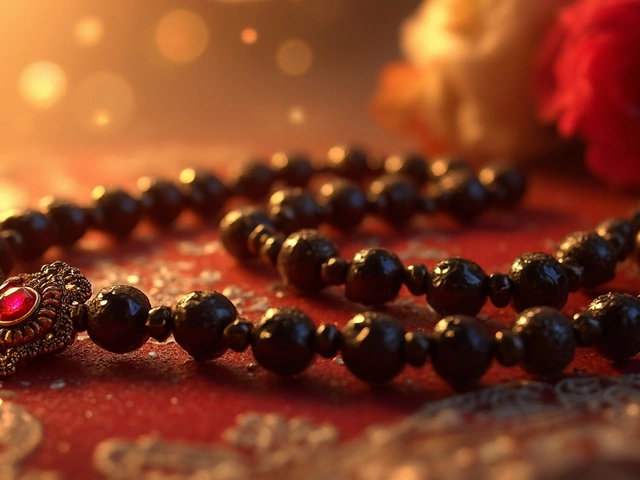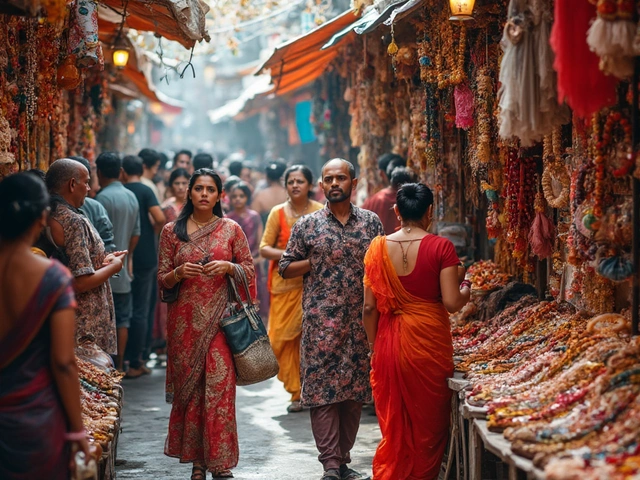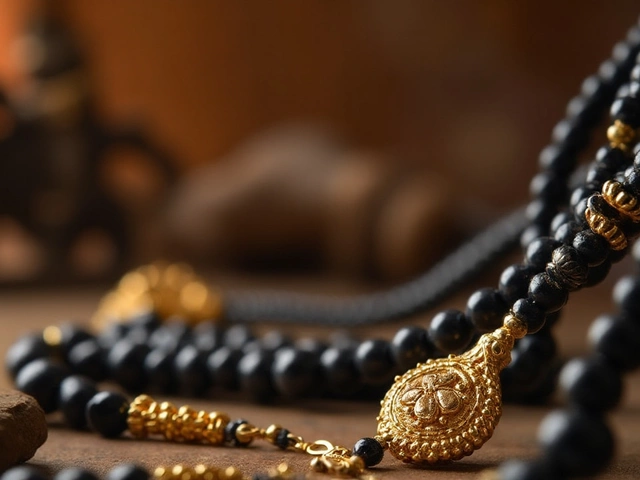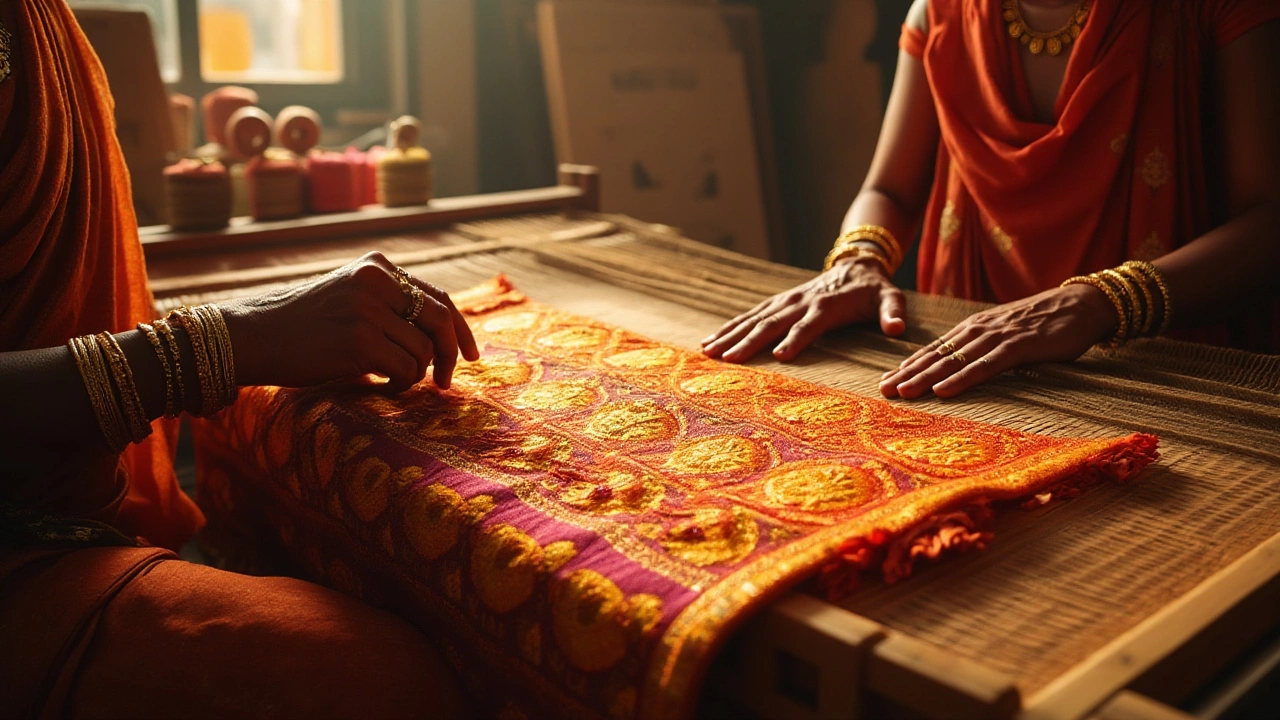
Kantha embroidery, known for its exquisite running stitch patterns, is a cherished art form originating from the quaint villages of eastern India. This rich tradition, passed down through generations, crafts beautiful narratives on fabric, using threads that are often recycled from old sarees.
The story of Kantha is woven not just with threads, but with the hands and hearts of the artisans who create them. These threads are more than mere strands; they are the lifeline of the art, each color and texture selected meticulously to add depth and character to the design.
Excitingly, these ancient patterns have found a new canvas in temple jewelry, where the threads of Kantha introduce a unique aesthetic, echoing the vibrancy and elegance of India’s artistic heritage. In this article, you'll explore how these elements intricately connect, enhancing the beauty of traditional temple jewelry with the soul of Kantha designs.
- Introduction to Kantha Embroidery
- Types of Threads Used in Kantha
- Cultural Significance and Artistic Interplay
- Kantha in Modern Jewelry Making
Introduction to Kantha Embroidery
Delving into the world of Kantha embroidery is akin to exploring a beloved tapestry of history and creativity. Originating from the lush regions of West Bengal and Bangladesh, Kantha stands out because of its simplicity and symbolism. Families have utilized this form of embroidery for centuries, often using discarded materials like old sarees or dhotis, weaving new life into them with every stitch. The defining feature of Kantha is its straightforward running stitch, a technique that allows artisans to craft intricate and meaningful designs. These stitches, though simple in appearance, form elaborate narratives that are often reflective of daily life, folklore, and spiritual beliefs. Each piece, therefore, becomes a unique story sewn onto fabric, echoing the voices of generations past.
The elegance of Kantha thread work lies in its minimalism and resourcefulness. Traditionally, women in rural communities would gather around, turning threads into tales, as they created these masterpieces surrounded by their kin. Personal and communal history is often captured in this embroidery, with patterns representing everything from lush flora to symbolic motifs such as the tree of life or the humble fish. This art was primarily domestic, practiced by women for domestic purposes, often as a loving gesture, turning cloth into quilts, covers, or even decorative items for personal use. Over the years, the prominence of Kantha has grown, with the world recognizing and appreciating its simplicity and cultural richness. As interest in sustainable and ethical fashion continues to rise, the timeless appeal of Kantha keeps making waves, inviting attention to its artistic resonance.
The very essence of Kantha can be described as 'improvisational'. Unlike many structured forms of needlework, Kantha allows for the artisan's personal touch and creativity to shine through. No two pieces are ever identical, as each artisan injects their unique flair and style into their work. Numerous artists have imbued their stitches with the essence of their surroundings, drawing inspiration from nature, local customs, and even familial tales. Michel du Montaigne, once eloquently stated,
"Craftsmanship names an enduring, basic human impulse, the desire to do a job well for its own sake."He could very well have been speaking of Kantha embroidery, where every thread speaks volumes of devotion and pride.
Kantha now has a modern-day renaissance, rekindling interest among contemporary artists and fashion houses worldwide. The global fashion industry has begun embracing its potential as both a traditional and trendsetting art form. Designers love the organic beauty and sustainability linked with Kantha thread work, incorporating it into a wide range of modern apparel and home décor items. Workshops teaching this art form are sprouting up across the globe, reaching a new generation eager to learn age-old traditions. The harmonious blend of time-tested simplicity and imaginative flair ensures that Kantha embroidery continues to thrive in the modern world, celebrated not just in India, but globally.
Types of Threads Used in Kantha
The art of Kantha embroidery is not only defined by its rich history and cultural significance but also by the meticulous selection of threads that are used to create its intricate designs. Traditionally, the Kantha thread comprises recycled yarns extracted from old sarees, a method that not only served as an early form of sustainability but also held deep-rooted cultural symbolism. Each thread tells its own story, having passed through the lives and hands of multiple generations, and it is imbued with sentimental value that enriches the fabric it adorns.
Historically, the colors and textures of the threads used in Kantha were carefully chosen, each color representing a particular emotion or element of the natural world. The vibrant reds and yellows, which often appear in Kantha work, are synonymous with happiness and prosperity, while blues and greens bring to mind the tranquility of water and the earth. The artisans select these colors not randomly but with intention, ensuring that each design represents harmony, balance, and grace. This thoughtful use of color transforms a simple piece of cloth into a tapestry alive with meaning and memory.
In the modern era, new materials have expanded the options for Kantha threads, with cotton and silk threads becoming more prevalent. These newer threads provide a glossy finish that enhances the art’s elegance, allowing it to shine in products ranging from clothing to home décor. According to Professor Neena Gupta, a textile historian, "Kantha embroidery evolves with time, offering a canvas for contemporary expressions, yet it retains the soul of its traditional roots."
The technique involved in preparing the Kantha threads is an art in itself. The process begins with carefully unraveling old fabrics, a task requiring patience and skill to ensure the threads remain unbroken. These threads are then rolled into neat bundles, a practice deeply symbolic of recycling and thriftiness. This aspect highlights an important aspect of Kantha; its roots in simplicity and mindful consumption. Increasingly, contemporary artists are experimenting with metallic threads and dyes, blending tradition with innovation to create pieces that are both striking and modern.
In addition to regular threads, certain variations of Kantha employ specialized threads resembling those used in temple jewelry, thus melding two traditional art forms. By using golden or silver threads typically seen in jewelry, these Kantha pieces gain an ethereal quality, bridging the tactile world of embroidery with the opulent allure of jewelry. Thus, the texture and type of thread not only determine the functional aspect of Kantha embroidery but also participated in its storytelling dimension.
The role of thread cannot be overstated; it is both a functional tool and a narrative instrument within each Kantha masterpiece. Whether extracted from long-forgotten garments or spun from modern silk, these threads are vibrant strands of history and creativity, joining each stitch in a celebration of continuity and change. The magical journey of these threads—from discarded fabric to artistic triumph—echoes the resilience and idyllic charm of Kantha itself, steadfastly colorful against the ebb and flow of time.
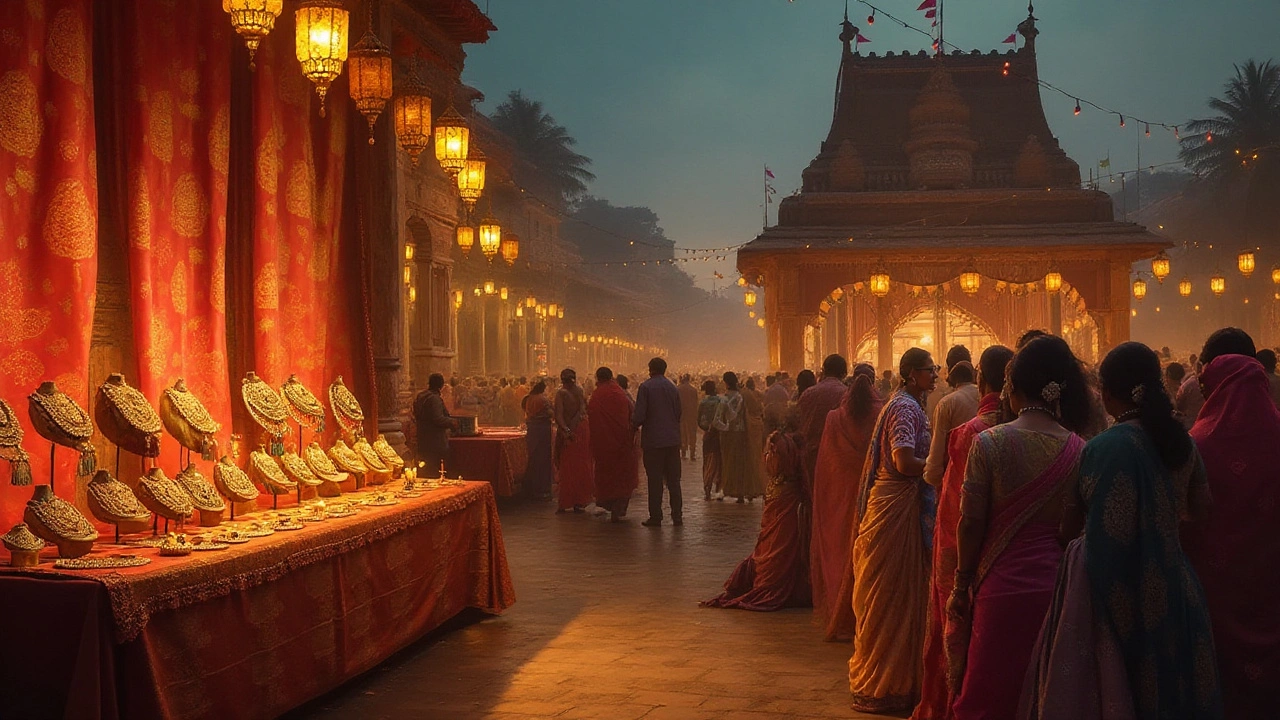
Cultural Significance and Artistic Interplay
In the vast tapestry of Indian art, Kantha embroidery and temple jewelry occupy a prominent place, both steeped in rich traditions and cultural narratives. Kantha, originating from the regions of West Bengal and Bangladesh, has not only served as a means of recycling old clothes and saris but has also been a form of storytelling, where each stitch narrates personal expressions, folk tales, and religious themes. Women primarily made these during their leisure times, creating pieces that often carried emotional significance. The legacy of these handcrafted textiles continues today, enchanting people worldwide with their simplicity and depth.
Delving into the essence of temple jewelry, one finds it rooted in South Indian tradition, known for its grandeur and intricacy. Once adorned by deities and classical dancers, these pieces are marked by their bold designs that reflect mythological stories and divine symbols. Combining Kantha's textile artistry with the opulence of temple jewelry creates a unique aesthetic synergy. Such artistic interplay brings together the rustic charm of embroidered narratives with the polished elegance of precious metals and stones, often creating stunning masterpieces that tell stories of tradition, art, and devotion.
"The fusion of Kantha and temple jewelry is like a kaleidoscope of stories woven through threads and gold. It speaks of history where art is both living and encapsulated," notes Ananya Bala, a renowned textile historian.
This harmonious blending extends beyond art, influencing contemporary fashion in India and beyond. Designers are now exploring more sustainable practices, using Kantha thread to accentuate traditional and modern pieces. This practice not only preserves the rich cultural heritage but also promotes women's empowerment, as many artisans are women from rural parts of India. Hence, each piece carries forward a legacy while empowering its creators. Such practices ensure that the traditional skills associated with Kantha embroidery stay alive, while also promoting a deeper appreciation for the artisans' talent and creativity in blending old with new.
Kantha in Modern Jewelry Making
As Kantha embroidery evolves from traditional textiles into the dazzling realm of modern jewelry making, it turns its humble stitch work into intricate art. This evolution marries the age-old craftsmanship of Kantha embroidery with contemporary design concepts, creating pieces that are more than jewelry—they are storytelling artifacts. Modern artisans have found a way to immerse the colorful threads of Kantha into the luxurious world of jewelry, often combining it with other precious materials like gold and gemstones to craft a harmonious blend that resonates with both authenticity and sophistication.
The use of Kantha thread in jewelry is not merely decorative; it embodies a philosophy that respects tradition while embracing innovation. Designers in India and beyond are increasingly drawn to this blend of the past and present, weaving narratives through color and texture that make every piece of jewelry unique. Some artisans focus on bold patterns and vibrant colors, while others introduce subtle tones to enhance the metalwork and gemstones, demonstrating the versatility of this embroidery technique. This creates a signature style that stands out in the crowded world of fashion.
"Kantha threads bring an essence of heritage that cannot be replicated," says renowned jewelry designer Manisha Aggarwal, describing how these threads add a personal touch to her collections.This statement is a testament to the impact of Kantha on the jewelry industry, acknowledging its role not just as an embellishment but as the soul of the piece. As a result, designers are experimenting with different applications of this technique, from intricate pendants and chokers to statement earrings and bracelets, elevating Kantha's position in haute couture.
The integration of Kantha into temple jewelry, which is traditionally associated with the divine and worn by deities, adds a spiritual dimension to its appeal. This fusion draws from the rich tapestry of Indian cultural motifs, creating a spiritual and visual dialogue between the pieces and their wearers. Furthermore, the lightweight nature of Kantha threads makes these jewelry pieces comfortable and practical for everyday wear, bridging the gap between artisanal craftsmanship and commercial viability.
For those intrigued by this unique convergence of artistry, there are several steps to consider when selecting a piece of temple jewelry infused with Kantha embroidery. First, identify your desired color palette and design style to ensure that the chosen piece aligns with your wardrobe and personal aesthetic. Consider the threading pattern and the quality of materials used, as these components add to the longevity and appearance of the jewelry. Pay attention to the craftsmanship, ensuring the embroidery is securely integrated into the jewelry setting, and appreciate the intricate detailing that comes with each handmade piece.
The emergence of Kantha in jewelry not only offers an exciting avenue for cultural expression but also supports sustainable practices. By repurposing threads and materials, artisans contribute to environmentally conscious fashion, which appeals to an increasing number of eco-aware consumers. In turn, this reflects a growing trend within the industry that prioritizes ethical production methods and celebrates the rich heritage of Indian textiles. For those curious about how Kantha continues to shape modern aesthetics, the intricate dance of thread and metal offers a captivating story of resilience, meaning, and beauty.
